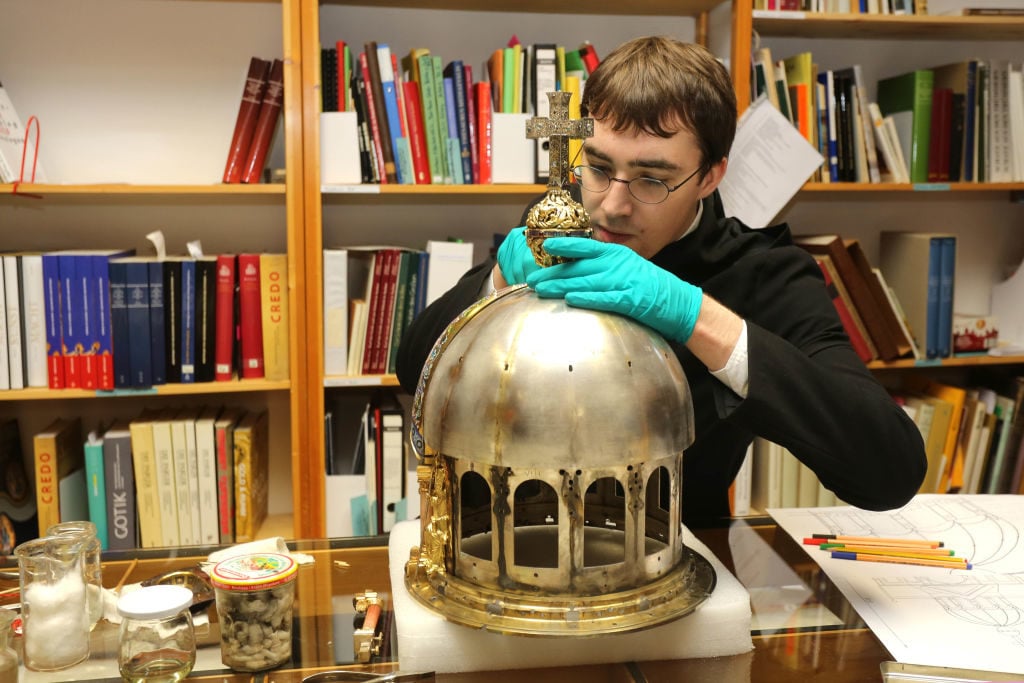Art World
A German Cathedral Plans to Display Its Shrine to Saint Corona, Who It Says Is the Patron Saint of Epidemics
But at least one scholar says the saint's connection to pandemics is not so clear.
But at least one scholar says the saint's connection to pandemics is not so clear.
Naomi Rea

One of Europe’s oldest cathedrals is getting a lot of attention for unearthing a group of relics tied to the little-known Saint Corona, who church representatives in Germany say is the patron saint of epidemics.
But at least one scholar is challenging that claim.
Workers at Aachen Cathedral were already restoring the reliquary well before the outbreak of the virus after the cathedral’s treasurer dug it out from storage more than a year ago in preparation for an exhibition on goldsmithery slated for the summer.
The ninth-century cathedral in Aachen, Germany, now says it will put the ornate shrine and relics on public view after the coronavirus pandemic has subsided.
But while some devotees may have already begun to pray to Corona for salvation, one theological expert is questioning the saint’s historical link to infectious diseases.
FACT CHECK: There is a St. Corona (d.170) but (1) she is not the patron saint of infectious diseases (look to St Edmund for that) (2) her name is from the vision she had of a crown & there are reasons to think she was invented (3) her remains are in Anzu, N.Italy #coronavirus pic.twitter.com/bwRpeDGLwb
— Candida Moss (@candidamoss) March 20, 2020
Candida Moss, a professor of theology at the University of Birmingham, tweeted that Saint Edmund, not Corona, is the patron saint of infectious diseases, and that Corona actually gets her name from her visions of crowns. (Corona is Latin for garland or crown.)
What’s more, Moss even says there is reason to believe that Saint Corona was invented altogether, and that if she did exist, her relics are in Northern Italy, not Germany.
“The veneration of saints is a very regional affair,” Moss tells Artnet News. “The way that Saint Edmund became the patron saint of plague victims—roughly 700 years after his death—was that residents in Toulouse, the city that housed his relics, prayed to him for healing during an outbreak of plague.”
“I think what we are seeing now is a substantial elevation in Corona’s profile,” she added. “The most cynical reading is that [church representatives in Germany] are being opportunistic, but it’s important to remember that this is exactly how saints have always become attached to particular professions or groups. Local events provoke a focused attention on a particular saint which, leads to that saint’s association with a particular group of people.”
“The thing with the epidemic is probably connected with her worship in the small town of St. Corona near Kirchberg am Wechsel,” a cathedral spokeswoman, Daniela Lövenich, tells Artnet News. “Here they asked for steadfastness in faith and called upon [the Saint] against storms, bad harvests and livestock epidemics.”
The cathedral’s head of treasury, Birgitta Falk, did not respond to requests for comment by press time.

Luke Jonathan Koeppe, a student of restoration and conservation science, cleans and preserves the shrine of St. Corona. Photo by Ralf Roeger/picture alliance via Getty Images.
Saint Corona is said to have been born either in 161 or 287, and although not much is known about her life, she is thought to have been martyred by the Romans, possibly in Syria, at the age of 16.
According to Reuters, emperor Otto III brought the relics to the cathedral in Germany in 997. They were kept in a tomb until the early 20th century, when they were moved to a 220-pound shrine made by the prominent Aachen goldsmith Bernhard Witte.
The church says the shrine was in storage for 25 years before Falk brought it out to be restored.
“Around 45 employees worked on this very detailed piece for almost a year,” Falk says in a description on the cathedral’s website. “The workshop almost went bankrupt in view of the effort and the costs.”
The detailed reliquary is in the shape of a Byzantine church with a cruciform structure, the end of which forms an ornamented 12-part dome.
But regardless of whether Corona can protect people against the virus, Falk told Reuters that she stands as a symbol of faith.
“Like many other saints,” she said, “Saint Corona may be a source of hope in these difficult times.”